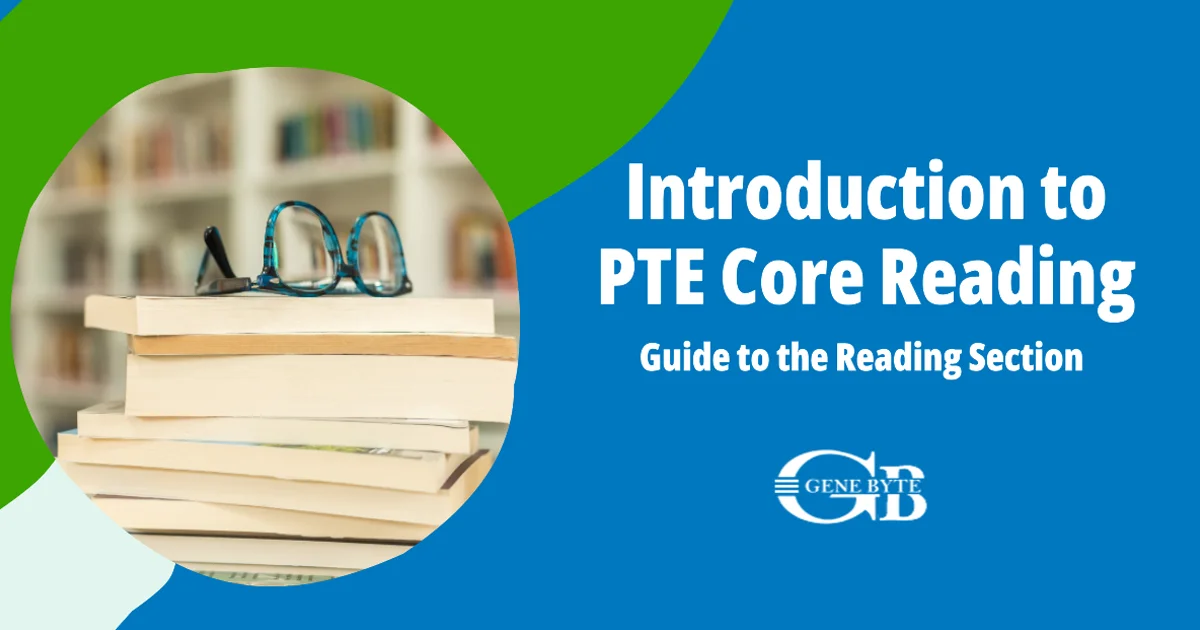PTE Core Insights:
PTE Core Reading for Educators
A Teacher's Guide to PTE Core Reading Section

"Familiarity with questions from past exams can improve the score of PTE Core Reading section."
As the Senior Manager at Genebyte, I've seen how specialized ed-tech can change how students tackle English proficiency exams. I want to talk about the Reading section of the PTE Core test, a key part that can really affect students' success.
The Reading section is tricky. It's not just reading but also analyzing and using information like in real life. Tasks like "Fill in the Blanks" and "Re-order Paragraphs" test deep understanding of English. The big challenge is not just to understand but to think critically and use smart strategies to do well.
At Genebyte, we see the Reading section as a chance to help. Our AI platform offers practice, resources, and insights on student performance, helping teachers boost their students' skills in this complex area.
We aim to prepare students for the PTE Core Reading section with the best tools and strategies. Join me, Ashok Chhikara, and see how Genebyte can elevate your institute's success.

Introduction to the Reading Section of PTE Core
In the vast expanse of language proficiency assessments, the Reading section of the PTE Core emerges as a critical component, meticulously designed to evaluate and enhance English reading skills. At Genebyte, we recognize the pivotal role this section plays in a candidate's journey towards English mastery. Here, we delve into the essence of the Reading section, its significance, and the unique set of challenges and opportunities it presents to both learners and educators.
Overview of PTE Core's Reading Section
The Reading section that follows the Writing Section is ingeniously crafted to mirror real-life engagement with English, demanding not just comprehension but a deep-seated ability to analyze and infer. Spanning across five distinct task-types—ranging from 'Reading and Writing: Fill in the Blanks' to 'Multiple-choice, Choose Single Answer'—this section is a testament to the multifaceted nature of reading in English. It challenges candidates to navigate through a variety of texts, discerning the correct responses through a blend of understanding and strategic thinking.
Importance of Reading Proficiency in PTE Core
Proficiency in the Reading section transcends beyond achieving a high score in the PTE Core; it equips learners with the essential skill of critical reading, which is indispensable in academic and professional settings. The ability to dissect texts, understand nuanced meanings, and draw informed conclusions is invaluable. This section serves as a cornerstone for developing such competencies, making its mastery a fundamental goal for PTE Core aspirants.
Unique Challenges and Opportunities
The Reading section's complexity is not without purpose. It simulates the diverse challenges encountered in real-world English usage, from academic texts to everyday materials, preparing students for a wide range of language encounters. However, this diversity also brings forth unique challenges, including time management across varying question types and the application of analytical skills under exam conditions.
Conversely, this complexity opens up numerous opportunities for teaching innovation. Educators, armed with the right tools and strategies, can guide students through these challenges, transforming potential obstacles into stepping stones for language proficiency. This is where Genebyte's platform shines, offering an array of resources and insights to turn the Reading section into a powerful learning experience.

Understanding the Structure of the Reading Section
The Reading section of the PTE Core is a critical component designed to assess a broad spectrum of reading skills, from comprehension to analysis. Here at Genebyte, we recognize the significance of this section for educators and students alike. This part of our discussion delves into the intricacies of time allocation and the variability of question items within the Reading section, providing a comprehensive overview that underscores our platform's capacity to enhance learning and teaching experiences.
Time Allocation and Management
One of the most distinctive features of the PTE Core's Reading section is its dynamic timing. The section is allocated a combined timer of 27-38 minutes, a window that necessitates precise time management skills from the candidates. This variability in timing underscores the need for a strategy that accommodates both the swift navigation through simpler tasks and the thoughtful engagement with more complex ones.
Genebyte's solution emphasizes the development of such strategies, offering practice modules that mimic the real exam's timing conditions. This not only acquaints students with the pace of the test but also equips teachers with data-driven insights into individual and group time management proficiencies.
Variability in Question Items
The Reading section's structure is further characterized by the variability in its question items. With a total of 13 to 18 questions spread across five distinct task types, the number of items for any given task can vary significantly from one test to another. These task types are:
- Reading and Writing: Fill in the Blanks
- Multiple-choice, Choose Multiple Answers (Reading)
- Re-order Paragraph
- Reading: Fill in the Blanks
- Multiple-choice, Choose Single Answer (Reading)
This variability presents both a challenge and an opportunity. It requires candidates to be adaptable, ready to tackle any combination of tasks thrown their way. For teachers, it emphasizes the importance of providing a comprehensive training approach that covers all bases.
| Task Type | Description | Potential Variability |
|---|---|---|
| Reading and Writing: Fill in the Blanks | Candidates fill in the blanks by dragging words from a given list to complete the text. | High - Due to the wide range of possible texts and vocabulary. |
| Multiple-choice, Choose Multiple Answers (Reading) | Candidates choose multiple answers from a list of options for a given reading passage. | Moderate - Reflects the complexity and length of the passages. |
| Re-order Paragraph | Candidates arrange given sentences or paragraphs in a logical order to reconstruct the text. | Moderate to High - Depending on the complexity of the text. |
| Reading: Fill in the Blanks | A text with several blanks is provided, and candidates fill each blank with an option from a dropdown list. | Low to Moderate - Focused on vocabulary and context understanding. |
| Multiple-choice, Choose Single Answer (Reading) | From multiple options, candidates select the one answer that they believe correctly completes the sentence or answers the question based on a reading passage. | Low - Generally focuses on understanding of a specific detail or main idea. |

Reading and Writing: Fill in the Blanks
Within the PTE Core Reading section, the Reading and Writing: Fill in the Blanks task stands as a multifaceted challenge, designed to assess a student's comprehension and vocabulary in tandem. At Genebyte, we recognize the importance of this question-type for educators striving to enhance their students' English proficiency. Here, we provide a comprehensive overview of this task, showcasing how our platform supports teachers in navigating its complexities.
Understanding Reading and Writing: Fill in the Blanks
This question-type presents candidates with a text passage containing several blanks. Students are required to fill these blanks from a given list of options, testing their ability to understand context, grammar, and vocabulary simultaneously. Success in this task relies not only on a student's reading comprehension skills but also on their ability to accurately apply their knowledge of English vocabulary and syntax.
Challenges and Strategies
The primary challenge of this task lies in its demand for a high level of language proficiency. Students must not only understand the passage as a whole but also be able to identify the most contextually appropriate words to complete the sentences. This requires a strong foundation in grammar and a wide-ranging vocabulary.
To address these challenges, Genebyte's platform offers targeted practice sessions focusing on:
- Vocabulary enhancement: Utilizing a curated list of commonly tested words to improve students' lexical range.
- Contextual learning: Engaging exercises that help students practice identifying the correct word based on the context of the passage.
- Grammar reinforcement: Comprehensive review materials and quizzes to solidify grammatical rules and usage.
| Strategy Component | Description |
|---|---|
| Vocabulary Building | Exercises designed to expand students' vocabulary with words frequently appearing in the task. |
| Contextual Practice | Activities focused on applying vocabulary and grammar rules within varied text passages. |
| Grammar Mastery | Resources and quizzes aimed at reinforcing grammatical knowledge crucial for task completion. |

Multiple-choice, Choose Multiple Answer (Reading)
In the realm of PTE Core, the Multiple-choice, Choose Multiple Answer question-type within the Reading section presents a unique set of challenges and opportunities for both students and educators. As part of Genebyte's commitment to enhancing the teaching and learning experience, we delve into the specifics of this task, highlighting how our platform equips teachers with the tools to navigate its complexities successfully.
Exploring the Task
This question-type requires candidates to read a passage and then select multiple correct answers from several options. It tests a wide range of reading skills, including the ability to understand implicit and explicit information, infer the writer's intent, and identify the main idea, supporting details, and conclusions.
Challenges Encountered
Students often find this task challenging due to its demand for high-level comprehension skills and the penalty for incorrect answers. Selecting multiple correct responses adds an extra layer of complexity, as it requires a thorough understanding of the passage and careful discrimination between closely related options.
| Strategy Component | Description |
|---|---|
| Comprehensive Practice | Exercises covering a broad range of topics and difficulty levels to prepare students for any passage they might encounter. |
| Skill-Specific Drills | Targeted activities focusing on critical reading skills, such as inference and detail identification, crucial for selecting correct answers. |
| Immediate Feedback | Real-time analysis and insights provided by Genebyte's platform, enabling students to learn from each attempt and refine their strategies. |

Re-order Paragraph
The Re-order Paragraph task in the PTE Core Reading section is a testament to the complexity and depth of English language comprehension. At Genebyte, we understand the critical role this question-type plays in evaluating a student's ability to understand logical flow and coherence in text. This section delves into the nuances of the Re-order Paragraph task, underscoring the unique advantages our platform offers to teachers aiming to elevate their students' proficiency.
Unraveling the Re-order Paragraph Task
This question-type presents students with a jumbled series of sentences that, once correctly arranged, form a coherent paragraph. The task assesses critical reading skills, including the ability to identify thematic links, understand sequence cues, and grasp the overall main idea. It challenges students to employ both their comprehension and analytical abilities, making it a pivotal component of the Reading section.
Addressing the Challenges
Students often face difficulties with this task due to its demand for a nuanced understanding of English syntax and organization. Recognizing thematic ties and logical progression within a text requires a deep engagement with the material, beyond surface-level comprehension.
| Strategy Component | Description |
|---|---|
| Understanding Cohesion | Exercises aimed at recognizing transitional phrases and cohesive devices crucial for sentence arrangement. |
| Theme Identification | Activities designed to enhance the ability to quickly identify the main idea and supporting details within paragraphs. |
| Logical Sequencing | Practice tasks that focus on ordering sentences based on chronological, cause-effect, and other logical relationships. |

Reading: Fill in the Blanks
In the journey toward mastering the English language, the Reading: Fill in the Blanks task within the PTE Core Reading section emerges as a pivotal challenge that tests more than just vocabulary. It examines a student's ability to understand context, utilize collocations, and apply grammatical knowledge effectively. At Genebyte, we recognize the intricate role this question-type plays in shaping a comprehensive understanding of English. Here, we delve into the specifics of this task, underscoring the innovative ways our platform aids teachers in enhancing student outcomes.
Navigating the Reading: Fill in the Blanks Task
This question-type presents candidates with a text passage containing blanks that they must fill by selecting the correct option from a dropdown list. Unlike other tasks, Reading: Fill in the Blanks requires a nuanced approach, as it demands an understanding of the text's overall context, the specific sentence's meaning, and the grammatical structure. Success hinges on a student's lexical resourcefulness and their ability to parse complex sentences for meaning.
Challenges and Tailored Solutions
The primary challenges associated with this task include expanding vocabulary, understanding nuanced language use, and applying grammar knowledge in context.
| Strategy Component | Description |
|---|---|
| Enhanced Vocabulary Acquisition | Exercises tailored to improve understanding of words and phrases within specific and broad contexts. |
| Grammar Reinforcement | Targeted practice focusing on grammatical structures relevant to the task, enhancing accuracy in selections. |
| Contextual Understanding | Activities aimed at developing the skill to infer meaning and make appropriate lexical choices in varied texts. |

Multiple-choice, Choose Single Answer (Reading)
The Multiple-choice, Choose Single Answer task in the PTE Core Reading section exemplifies the nuanced nature of English comprehension and decision-making. At Genebyte, we are committed to empowering educators with the knowledge and tools necessary to navigate this and other complex aspects of language assessments. This section delves into the specifics of this particular question-type, illustrating how our platform facilitates a deeper understanding and more effective teaching strategies.
Deciphering the Task
In the Multiple-choice, Choose Single Answer task, students are presented with a passage followed by a question. Among several options, only one is correct. This task assesses a range of skills, from understanding main ideas and details to inferring the author's purpose or the tone of the text. The challenge lies not only in comprehending the passage but also in applying critical thinking to select the most appropriate answer.
Addressing the Challenges
The primary challenge students face with this task is distinguishing between similarly plausible answers. This requires a robust command of vocabulary, an understanding of text structure, and the ability to critically evaluate subtle nuances in the content.
| Component | Description |
|---|---|
| Diverse Reading Practice | Providing texts across a spectrum of subjects and styles to build versatile reading capabilities. |
| Analytical Skill Building | Exercises focused on enhancing the ability to analyze text and distinguish between answer choices. |
| Personalized Feedback | Leveraging AI to offer individualized insights into performance, fostering a tailored approach to learning. |

Scoring Mechanism in the Reading Section
In the intricate landscape of the PTE Core, understanding the scoring mechanism of the Reading section is pivotal for both educators and students. At Genebyte, we prioritize demystifying this aspect, revealing how our platform can significantly aid teachers in optimizing their students' preparation strategies. This segment explores the scoring system, its integrated nature, and the sophisticated role of algorithms, underlining how our solutions cater to these facets.
Overview of the Scoring System
The Reading section in the PTE Core exam is meticulously designed to gauge a candidate's proficiency in understanding written English. It boasts a total score of 45 for the section, contributing to a comprehensive skill score of 90. This scoring reflects not only the candidate's direct responses within the Reading section but also their mastery over English reading skills in a broader sense.
Integrated Scoring Explained
A unique feature of the PTE Core's scoring system is its integrated approach. The Reading section does not stand in isolation; it dynamically interacts with other sections of the test. For instance, certain tasks in the Speaking, Writing, and Listening sections can influence the Reading score, and vice versa. This interconnectedness emphasizes the need for a holistic understanding and preparation strategy that covers all aspects of the English language.
Genebyte's platform leverages this integrated scoring model by providing a suite of practice materials that span across all sections, enabling students to develop their skills in a comprehensive manner. This approach ensures that teachers can effectively prepare students for the intertwined nature of the exam, maximizing their overall performance.
The Role of Algorithms in Scoring
The PTE Core utilizes advanced algorithms to evaluate candidates' responses. This complex system takes into account various factors, including the accuracy and relevance of the answers, to allocate scores. The algorithm's intricacies can seem daunting, but understanding its basics can greatly benefit educators in guiding their students.
Genebyte demystifies this process by offering insights into the scoring algorithms through detailed analytics and feedback. Our platform's analysis tools help teachers identify patterns in students' performances, shedding light on how different types of responses are scored. This knowledge enables educators to tailor their teaching methods to better align with the scoring criteria, thereby improving students' chances of achieving higher scores.
| Component | Description |
|---|---|
| Total Section Score | The Reading section contributes 45 points towards the comprehensive skill score of 90. |
| Integrated Scoring Impact | Reading scores are influenced by and contribute to other sections, underlining the importance of holistic preparation. |
| Algorithmic Evaluation | Advanced algorithms assess responses, considering various factors to determine scores accurately. |

Integrated Scoring Dynamics
In the nuanced ecosystem of the PTE Core exam, the Reading section does not exist in isolation. Its integrated scoring dynamics, where marks are exchanged between Reading, Writing, Speaking, and Listening sections, represent a key feature that sets this assessment apart. At Genebyte, we emphasize the significance of these dynamics, ensuring that educators are well-equipped with the knowledge and tools to prepare students effectively. This section explores the interconnectedness of the exam's components and the strategic importance of understanding these relationships in coaching strategies.
Contributions to and from Other Sections
The PTE Core exam's scoring system is designed to reflect a candidate's overall language ability, which necessitates a comprehensive approach to language learning and assessment. Marks are not only garnered within the Reading section but also contributed from and to the Speaking, Writing, and Listening sections. For instance, tasks in the Speaking section that require reading comprehension contribute to the Reading score, while understanding heard information in the Listening section may influence marks in Reading through integrated tasks. Similarly, the ability to interpret and analyze texts in the Reading section can enhance performance in the Writing section, demonstrating the reciprocal nature of these skills.
Significance of Integrated Scoring
The integrated scoring mechanism underscores the necessity for a holistic approach to PTE Core preparation. It emphasizes the importance of developing well-rounded language skills, where improvement in one area can positively affect performance across the board. This interconnectedness presents a unique opportunity for educators to devise teaching strategies that are multifaceted and comprehensive, catering to the interlinked nature of language skills.
Genebyte's platform is tailored to support this integrated approach to exam preparation. Our resources and practice materials are designed to not only target specific skills within each section but also to highlight and strengthen the connections between them. By facilitating an understanding of how these sections interplay and contribute to the overall score, we enable educators to adopt more effective and strategic teaching methodologies.
| Exam Section | Contribution to Reading | Receives Contributions from Reading |
|---|---|---|
| Speaking | Through tasks requiring understanding of written prompts. | N/A |
| Writing | Through tasks that involve reading comprehension. | Through analysis and interpretation of texts. |
| Listening | Through tasks where reading comprehension is necessary to understand heard information. | N/A |
| Reading | Through direct performance in reading tasks. | Provides foundational skills enhancing performance in Writing. |

Strategies for Tackling the Reading Section
In the pursuit of PTE Core excellence, the Reading section presents a unique set of challenges that demand strategic preparation. At Genebyte, we understand that success in this area is not just about knowledge acquisition but about mastering specific strategies tailored to the task at hand. This section focuses on the nuances of objective-style answers, the limitations of template-based approaches in Reading, and the conceptual strategies that can significantly enhance reading comprehension skills.
Objective-style Answers and Their Implications
The Reading section of the PTE Core is characterized by its reliance on objective-style questions, which require students to select or identify correct answers rather than produce them independently. This format tests not only a student's understanding of the text but also their ability to navigate and interpret multiple-choice questions, fill in the blanks with accurate words, and reorder paragraphs to reflect the correct sequence of ideas.
The primary implication of this format is the necessity for precision and analytical thinking. Unlike subjective answers, where there's room for personal interpretation and argumentation, objective-style answers leave little margin for error. This necessitates a deep understanding of the text and the ability to discern subtle nuances in language and meaning.
Limitations of Template-based Approaches
In sections such as Speaking and Writing, templates can serve as useful scaffolds, guiding students in structuring their responses. However, the Reading section's objective nature means templates offer no advantage here. Success in Reading requires a different set of strategies, focused more on comprehension, analysis, and critical thinking rather than on memorization and reproduction of set patterns.
Approaches to Enhancing Reading Comprehension Skills
Genebyte's platform provides an array of tools and strategies designed to bolster reading comprehension skills, directly addressing the challenges posed by the Reading section:
- Diverse Reading Materials: Exposure to a wide range of texts prepares students for the variety they'll encounter in the exam. Our curated content spans numerous topics and genres, enhancing adaptability and comprehension.
- Critical Analysis Exercises: Activities focused on identifying main ideas, supporting details, and inferential meanings help students practice the analytical skills necessary for success in objective-style questions.
- Vocabulary Expansion: A strong vocabulary is essential for understanding and interpreting Reading passages. Our platform includes vocabulary-building exercises that are integrated with reading practice, enabling students to learn new words in context.
- Practice Tests with Instant Feedback: Real-time feedback on practice tests allows students to learn from their mistakes and understand why certain answers are correct. This immediate correction and explanation facilitate deeper learning and improvement.
| Strategy Component | Description |
|---|---|
| Diverse Reading Practice | Engaging with texts of varying topics, styles, and complexity. |
| Analytical Skill Development | Honing the ability to dissect and understand passages beyond the surface level. |
| Vocabulary Building | Expanding lexical range to improve text interpretation. |
| Practice with Feedback | Utilizing real-time feedback to refine understanding and approach. |

The Importance of Familiarity with Material in the PTE Core Reading Section
The Reading section of the PTE Core exam is a testament to the complexity and depth of the English language, challenging students to understand, analyze, and infer from diverse texts. At Genebyte, we recognize the pivotal role that familiarity with exam material plays in achieving success. This understanding forms the backbone of our B2B SaaS solution, designed to equip coaching institutes with the tools needed to elevate their teaching methodologies and student outcomes effectively.
Repetition of Material Across Exams
A notable characteristic of the PTE Core exam is the recurrence of themes and question types across different test administrations. This repetition offers a strategic advantage for those well-acquainted with previous exam materials. By engaging with and analyzing past questions, students can gain insights into the exam's structure, familiarize themselves with the types of texts presented, and develop strategies for tackling similar questions in the future.
Advantage of Going Through and Memorizing Previous Questions
Memorization of previous questions and their answers can serve as a powerful tool in a student's preparation arsenal. This approach not only aids in building a robust vocabulary and enhancing comprehension skills but also instills confidence in students as they encounter familiar material during the actual exam. Genebyte's platform supports this strategy by providing access to a comprehensive database of past PTE Core questions and answers, enabling students to practice and revise effectively.
Tailoring Study Plans to Leverage Repeated Material
Understanding the patterns and repetitions within the PTE Core Reading section allows educators to tailor study plans that optimize preparation efforts. By focusing on areas frequently covered in the exam, teachers can ensure that their students are concentrating on the most relevant and beneficial material. Genebyte's platform facilitates this customization, offering tools that allow educators to create and adjust study plans based on the analysis of past exam content and student performance data.
| Strategy Component | Description |
|---|---|
| Analyzing Past Questions | Regular review sessions focusing on questions from previous exams to identify common patterns. |
| Vocabulary and Comprehension | Emphasizing words and concepts frequently encountered in past exams to build a solid foundation. |
| Customized Practice Sessions | Creating practice tests that mirror the structure and content of previous exams for targeted preparation. |

Actionable Tips for Educators
As we conclude our exploration of the Reading section in the PTE Core exam, it's clear that a strategic approach, bolstered by a thorough understanding of the exam's structure and scoring dynamics, is paramount. As educators, your role in guiding students through this intricate landscape cannot be overstated. Here are actionable steps and recommendations to enhance your teaching strategies and help your students excel:
- Diversify Reading Materials: Incorporate a wide range of texts into your curriculum to mirror the variety found in the PTE Core. This will not only prepare students for the exam but also enrich their overall English proficiency.
- Focus on Analytical Skills: Emphasize the importance of analyzing texts beyond their surface meaning. Encourage students to practice identifying main ideas, supporting details, and the author's purpose to improve their comprehension and analytical abilities.
- Leverage Past Exam Questions: Make use of the repetition of themes and question types across exams. Reviewing and practicing with previous questions can give students a significant edge.
- Implement Targeted Vocabulary Building: Expand your students' lexical range with exercises designed to introduce and reinforce vocabulary frequently encountered in the PTE Core Reading section.
- Utilize Technology and Tools: Genebyte's B2B SaaS solution for coaching institutes offers an unparalleled resource in this endeavor. Our platform provides a comprehensive suite of tools and resources, including practice materials, analytics, and feedback systems, all designed to align with the objectives of the PTE Core exam. By integrating our technology into your teaching strategies, you can offer a more personalized and effective preparation experience for your students.
In essence, the path to PTE Core Reading section mastery involves a balanced combination of broad reading practice, analytical skill development, strategic use of past materials, and targeted vocabulary enhancement. Genebyte stands ready to support coaching institutes in this journey, offering a platform that not only addresses the unique challenges of the Reading section but also empowers educators to elevate their teaching methodologies. After reading, students proceed to the final part of the exam, the Listening Section, marking the end of the test.
We invite you to explore further how Genebyte can transform your approach to PTE Core preparation. Whether you're looking to understand more about our platform, sign up for a trial, or schedule a demonstration, we're here to assist you in achieving the best outcomes for your students. Together, we can unlock their potential and pave the way for their success in the PTE Core and beyond.
Visit our website or contact us directly to discover how Genebyte's B2B SaaS solution can become an integral part of your educational toolkit, ensuring that your students not only meet but exceed their PTE Core goals.
Frequently Asked Questions
The Reading section in PTE Core is meticulously organized to assess a wide range of reading skills. It encompasses 5 distinct task-types including "Reading and writing: Fill in the blanks," "Multiple-choice, choose multiple answers," "Re-order paragraph," "Reading: Fill in the blanks," and "Multiple-choice, choose single answer," offering a comprehensive evaluation of a candidate's reading ability.
The PTE Core Reading section's format is designed to challenge test-takers with a variety of question types, from multiple-choice questions to reorder paragraphs and fill-in-the-blanks tasks. This diverse format ensures a thorough assessment of the candidate's reading comprehension, vocabulary, and grammatical understanding.
Typically, the Reading section features between 13 to 18 questions spread across its various task-types. The exact number can vary, reflecting the test's adaptive nature to comprehensively gauge a candidate's reading skills.
Components of the PTE Core Reading section include five main task-types:
- Reading and writing: Fill in the blanks
- Multiple-choice, choose multiple answers
- Re-order paragraphs
- Reading: Fill in the blanks
- Multiple-choice, choose a single answer
The Reading section has a combined timer ranging from 27 to 38 minutes, depending on the total number of questions and the complexity of the tasks presented in the exam session.
Marks in the Reading section are allocated based on the accuracy and completeness of the responses. The total score for the Reading section's task-types is 45, contributing to a comprehensive Reading skill score of 90, factoring in integrated tasks from other sections.
Integrated scoring significantly influences the Reading section as it contributes marks to and receives marks from the Speaking, Writing, and Listening sections. This holistic scoring approach underscores the importance of well-rounded English language proficiency.
Familiarity with previous exam materials is crucial. It enables candidates to understand the exam's format better, anticipate the types of questions, and practice with content that mirrors the real test, ultimately enhancing preparation and performance.
Recommended strategies include diverse reading practice to build familiarity with various text types, focused practice on each question-type, time management training, and regular review of past PTE Core questions for patterns and recurring themes.
Teachers can enhance performance by integrating a mix of reading materials in their curriculum, emphasizing analytical skills and critical thinking, and employing targeted practice sessions using Genebyte's platform for personalized feedback and strategies.
Templates are not applicable to the Reading section due to its objective-style question format. Success in this section relies on comprehension, vocabulary, and analytical skills rather than fixed response formats.
Effective time management involves practicing with timed sections to become comfortable with the pace of the test, allocating time based on the difficulty and length of each task-type, and developing quick decision-making skills to ensure all questions are attempted within the allocated time frame.